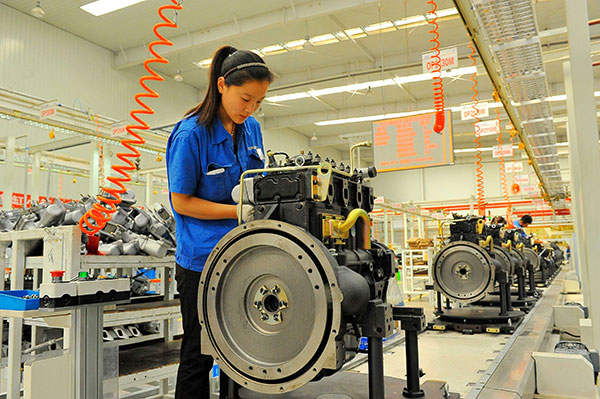
Workers assemble engines at a factory in Weifang, Shandong province. (Photo by Wang Jilin / China Daily)
The Caixin flash China general manufacturing PMI plunged to a 78-month low of 47.0 in September from 47.3 in August, suggesting continued downward pressure facing the world's second largest economy, a preliminary Caixin survey showed on Wednesday.
The sub-index on manufacturing output retreated to a 78-month low of 45.7 in September from 46.4 in August, according to the survey of Caixin Media Co Ltd.
"The decline indicates the nation's manufacturing industry has reached a crucial stage in the structural transformation process. Overall, the fundamentals are good," said Dr. He Fan, chief economist at Caixin Insight Group.
He pointed out that weakening factory activity is tied to previous changes in factors related to external demand and prices.
The flash index is published on a monthly basis ahead of final PMI data, making it the earliest available indicator of manufacturing conditions in China.
The estimate is based on approximately 85 to 90 percent of total PMI survey responses from over 420 manufacturing companies each month and is designed to provide an indication of the final PMI. The final PMI for September will be released on Oct 1.
The data showed considerable headwinds to growth from soft global demand and the index's focus on export-oriented sectors had been the biggest reason behind its decline in recent months, given the heavy export-related component in the overall order book, according to Qu Hongbin, Chief China Economist at HSBC.
Market sentiment was dampened by the poor flash PMI reading with the benchmark Shanghai Composite Index plunging over 2 percent by mid-day.
China's economy, a key driver of global growth, expanded 7.4 percent last year, the weakest since 1990, and has slowed further this year, growing 7 percent in each of the first two quarters.
China's value-added industrial output expanded 6.1 percent year on year in August, according to the National Bureau of Statistics (NBS). The growth rate was up slightly from 6 percent in July, but still fell short of market expectations.
The decline in output growth ended a steady recovery trend recorded in the second quarter of this year.
Fixed-asset investment, a major driver of growth, rose 10.9 percent year on year in the first eight months, retreating from the 11.2-percent growth registered in the first seven months, NBS data showed.
The Chinese economy is still operating within the proper range, Chinese President Xi Jinping said in an interview published in the Wall Street Journal on Tuesday ahead of his state visit to the United States from Tuesday to Friday.
Although downward pressure on the economy may persist for a while, the Chinese government has plenty policy room and options to achieve its annual growth targets, the country's top economic planner said in a statement on Tuesday.
In the coming months, China's investment-stimulating policies will help stabilize investment growth to offset the impacts of sluggish exports, and the recovering property market and booming service industry will also contribute to growth even though difficulties for traditional industries will persist, according to the statement.
According to Qu's observation, there have been some signs of cyclical recovery in the property market and better access to funding for infrastructure projects in recent months, which should lay the ground for a modest ground rebound towards the end of the year.
Fiscal expenditure surged in August, pointing to stronger government efforts on the fiscal policy front. Patience might be needed for policies designed to promote stabilization, He said.
China has reduced benchmark interest rates four times and lowered the reserve requirement ratio (RRR) three times to stimulate the economy since November last year..
HSBC forecasts further monetary easing measures, including another 150 bps RRR cut. Fiscal expenditures and municipal bond insurance growth is expected to remain at a fast pace in coming months.


















































